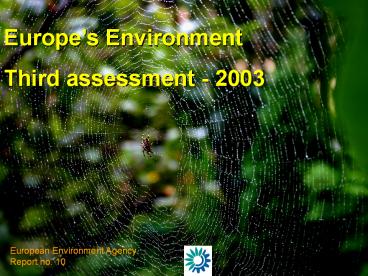EEA 3rd Assessment - PowerPoint PPT Presentation
1 / 10
Title:
EEA 3rd Assessment
Description:
Here you can read only a brief information what can be found in this report in ... Most of data presented and discussed in the assessmentare covering the period of ... – PowerPoint PPT presentation
Number of Views:15
Avg rating:3.0/5.0
Title: EEA 3rd Assessment
1
Europes Environment Third assessment - 2003
European Environment Agency Report no. 10
2
The Third Assessment is the environmental report
for Europe was prepared by the European
Environment Agency (EEA) for the environment
ministers conference in Kiev in May 2003. The
report follows two former editions published in
1995 (Dobris Assessment) and 1998 (Second
Assessment). The report is giving an overview of
progress in the EnvironmentalvProgramme for
Europe. It covers wider area in comparison to
former reports, including also data from Russian
Federation, the Caucasian and central Asian
countries
3
The Report as the .pdf file can be found and read
from the EEA web site www.eea.org.int Here you
can read only a brief information what can be
found in this report in order to upgrade your
knowledge on recent environmental problems
throughout the Europe. You are adviced for using
this additional reference material for your study
in Environmental Sciences course.
4
The assessment presents the indicators in a
series of summarising boxes
- positive trend, moving towards qualitative
objectives or quantified targets - some positive development, but either
insufficient to reach qualitative objectives or
quantified targets, or mixed trends within the
indicator - unfavourable trend.
5
The assessments in this report are based on
indicators of the assessment which cover
important aspects of the socio-economic and
environmental framework They are driving forces,
pressures, state of the environment, impacts and
societal responses. The name used for the
framework is DPSIR, (from the first letters of
the driving forces)
Source EEA
6
- The assessment covers 4 main areas
- Developments in socio-economic sectors
- Prominent environmental problems
- Cross-cutting impacts
- Policy management
- and annexes showing
- Country tables of key statistics
- Ratification of multilateral environmental
agreements - Comparisons with other parts of the world
7
- Developments in socio-economic sectors covers
- Material flows
- Industry
- Energy
- Agriculture
- Forestry
- Fisheries and aquaculture
- Transport
- Tourism
8
- Cross-cutting impacts
- Biological diversity
- Environment and human health
- Policy management
- Progress in managing the environment
- Information gaps and needs
9
- Prominent environmental problems concentrate on
- Climate change
- Stratospheric ozone depletion
- Air pollution
- Chemicals
- Waste Water
- Soil degradation
- Technological and natural hazards
10
Most of data presented and discussed in the
assessmentare covering the period of late
ninieties, up to the year 2001 when the
conference on European ministers responsible for
environment took place in Kiev.































